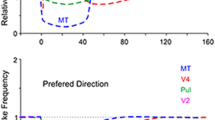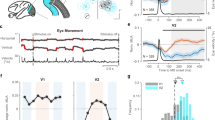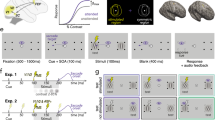Abstract.
Microstimulation of the intermediate layers of V1 in rhesus monkeys disrupts target selection with saccadic eye movements. To study target selection, one visual target was presented in the receptive-field location of the stimulated neurons and a second target was presented outside this location. Microstimulation delivered with the appearance of the two targets decreased the probability that the monkey would select the target placed in the receptive-field location when intermediate layers of V1 were stimulated. This interference effect was more pronounced when anodal-first pulse pairs were used as compared to when cathodal-first pulse pairs were used. The superior effectiveness of anodal pulses suggests that the interference effect is due to activation of axonal terminals residing within intermediate V1.
Similar content being viewed by others
Author information
Authors and Affiliations
Additional information
Electronic Publication
Rights and permissions
About this article
Cite this article
Tehovnik, E.J., Slocum, W.M. Microstimulation of macaque V1 disrupts target selection: effects of stimulation polarity. Exp Brain Res 148, 233–237 (2003). https://doi.org/10.1007/s00221-002-1312-5
Received:
Accepted:
Issue Date:
DOI: https://doi.org/10.1007/s00221-002-1312-5




